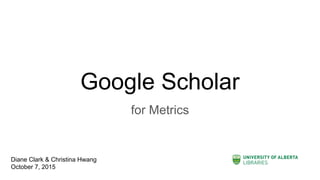Using google scholar for metrics
- 1. Google Scholar for Metrics Diane Clark & Christina Hwang October 7, 2015
- 2. Our Session Description Google Scholar is a popular tool for monitoring how your publications are cited. Join us for a workshop introducing Google Scholar’s advantages (e.g., ease of use) and limitations (e.g., transparency). Set up your Google Scholar researcher profile, discovering your h-index in the process, in a few minutes. Learn how to set up a Google Alert, another tool that can provide a view on your impact.
- 3. Outline â—Ź Google Scholar Advantages & Limitations â—Ź Set up your Google Scholar Profile â—Ź Google Alert and other settings
- 4. “The search engine functionality and human search patterns lead us to believe, sometimes, that what you see in the search engine's results page is all that really exists” (Orduña-Malea et al., 2014)
- 5. 170 - 175 mil 57 mil 53 mil Orduna-Malea et al 2015 Does Size Matter?
- 6. Google Scholar - Advantages & Disadvantages Pro ● coverage ● getting better ● use with Publish or Perish for best results ● promote “hidden gems” ● repositories e.g. Arxiv, SSRN, NBER and RePEC, ERA (UA’s institutional repository) ● retrieves open databases e.g. PubMed ● institution affiliation search (new) Con ● coverage ● data quality ● no connection to ORCID ● not all publisher content ● transparency
- 7. List of cited by Conference proceeding Citeseer - scientific literature digital library & search engine No link to Scopus
- 8. Where cited by (Times Cited) results are retrieved
- 9. 59 Cited by - information not available in Google Scholar Journals
- 10. Google Scholar v Web of Science / Scopus â—Ź Architecture and technology â—Ź Policy and management (business) â—Ź Economics â—Ź Engineering â—Ź Computer Science â—Ź Chemistry â—Ź Applied science â—Ź Biomedicine â—Ź Economics â—Ź Pharmacology â—Ź Physics â—Ź Cell Biology
- 13. Conference proceeding Uploading Your Citations to Your CCV
- 15. Google Alert and Other Settings â—Ź Google Alert - email alerts â—Ź Journal ranking â—Ź Ualberta Libraries linking â—Ź Reference Manager / CCV / ORCID exporting
- 16. Other Options for Managing Citations
- 17. References Harzing, A.W. Alakangas, S. (2015) Citation metrics versus peer review: a longitudinal comparison of Google Scholar, Scopus and Web of Science citation data across disciplines, symposium contribution at the 72nd Academy of Management annual meeting, August 7-11, in Vancouver, Canada. Harzing, A.W. (2014) A longitudinal study of Google Scholar coverage between 2012 and 2013,Scientometrics, vol. 98, no. 1, pp. 565-575. LisĂ©e, C., Larivière, V., Archambault, E. (2008). Conference Proceedings as a Source of Scientific Information: A Bibliometric Analysis. Journal of the American Society for Information Science and Technology, 59(11):1776–1784. MartĂn-MartĂn, Orduña-Malea, AyllĂłn, LĂłpez-CĂłzar (2014). Does Google Scholar contain all highly cited documents (1950- 2013)?. arXiv Orduña-Malea, E.; AyllĂłn, J.M.; MartĂn-MartĂn, A.; Delgado LĂłpez-CĂłzar, E. (2015). Improvements in Google Scholar Citations are for the summer: Creating an institutional affiliation linking feature. Granada: EC3 Reports, 14. Orduña-Malea, AyllĂłn, MartĂn-MartĂn, Delgado LĂłpez-CĂłzar (2015). Methods for estimating the size of Google Scholar. Scientometrics

















